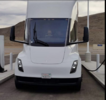There have been some recent stories about Tesla announcing 1MW wireless induction charging for semis.
How would this work at an Interstate truck stop - like a Flying J. How many trucks would they need to be able to charge simultaneously, and do these locations have large enough transmission lines to handle the power requirements. I can imagine that being an issue at some rural locations.
How would this work at an Interstate truck stop - like a Flying J. How many trucks would they need to be able to charge simultaneously, and do these locations have large enough transmission lines to handle the power requirements. I can imagine that being an issue at some rural locations.




